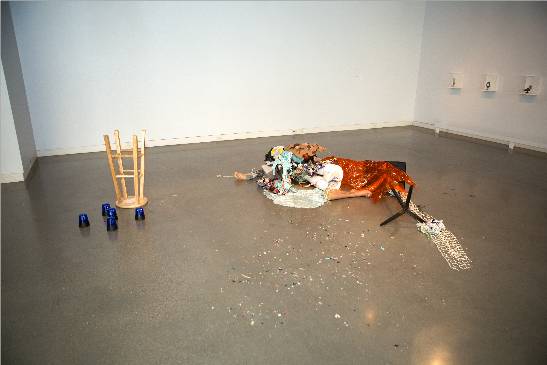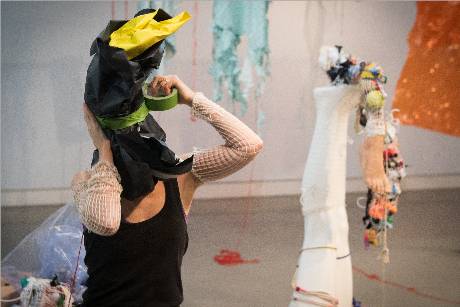Alexandra Kadlec
RAPHAELLA DE GROOT:
SEARCHING IN THE SPACE OF PERFORMANCE
It is April 10, 2015, opening night of the international disability arts exhibition, Art of the Lived Experiment, in Grand Rapids, Michigan. A crowd gathers around the periphery of a stark gallery space inside the Urban Institute for Contemporary Arts (UICA) downtown. Cluttering the floor is a miscellany of objects that draw intrigue: a large sheet of orange cellophane, a roll of duct tape, multi-colored ribbons, thin white netting, the lower half of a mannequin. These and other items will become the aids, appendages, and encumbrances to artist Raphaelle de Groot during the labored performance she is about to give.

Performance by Raphaelle de Groot for Art of the Lived Experiment
Urban Institute for Contemporary Arts, Grand Rapids, MI
Courtesy Kendall College of Art and Design
Photo: Matt Gubancsik
What the audience bears witness to over the next hour and a half is a series of plotted and improvised moments whereby de Groot walks around, picks up, tapes and binds the found materials (selected randomly from a storage room at the UICA) to her body.
A pivotal moment—for both the artist and the crowd—occurs early on, when de Groot's face and vision become obscured by the thick paper she has wrapped around her head. Her viewers are suddenly given a glimpse into what cannot be seen, but only imagined: de Groot's inner world.

In both presentation and content, Art of the Lived Experiment addresses the experience of disability through a kaleidoscopic lens. The exhibition, which premiered at the deaf and disability art festival DaDaFest International 2014 in Liverpool, England, more broadly speaks to the inevitable process of change, within and outside of our bodies and minds. It asks the question, How do we (all) interact in a world that can work for or against us? And, how must we adapt?
Throughout De Groot's performance, a certain dichotomy illustrates these themes: the objects she heaps on herself become physically inhibiting, while others act as her guide. At one point she stands atop a bar stool, toes curled, legs quivering slightly, grasping for a lone piece of string on a music stand nearby; things that become a bridge to the following act, and the next thing. Later, when several of the objects are strapped to her back, the burden is palpable, extending outwards into the realm of others' experiences.
The physical and emotional vulnerability required of the artist to undertake such a performance is both captivating and unsettling to observe. De Groot has chosen to become exposed to her audience, to cede control of how each movement as well as her viewers' responses will take shape. This dynamic is akin to the experience of entering the public sphere with a physical, emotional or mental disability without knowing how it will be received, judged, understood—or if it will even be perceived at all.
To take one step back, we might ask why de Groot has chosen to add disabling elements to her body at all. What is meaningful about the space she creates and how she approaches it? The artist embarked on performance art in 2002, laden with discomfort towards the medium as well as complex questions she didn't (and still doesn't) expect to resolve. Among them, What is the artist? And what is the role of the artist? And how do I represent that?
Whereas previous projects involved de Groot exploring the unknown worlds of other people—textile workers, nuns, domestic workers—from more of an anthropological rather than aesthetic position, the artist suddenly felt the need to come back to herself. To confront her questions by creating an artistic gesture with her own body, to flip the dynamics of process and gain new perspective on her practice. She explains that was less about the outcome, more about the search. "I don't feel I ever find anything as an artist," de Groot concedes, "but what drives me is the not knowing, and the discomfort that goes along with it."
The artist describes the creative process itself as being lost, of a continual struggling and seeking. "You know how you're starting out, but you don't know how it's going to end. You're just moving forward."
An active curiosity seems to inform, more broadly, de Groot's approach to life. During a phone call to discuss her involvement in Art of the Lived Experiment within the broader context of her work, she was eager to first hear my thoughts and reactions. How did I come up with the questions for her interview? What was my experience on opening night? It was evident that the dialogue, more than the answers, was the meaningful part.
In many ways the artist and audience are in her performance for Art of the Lived Experiment together; both blocked from the other's view, facing doubts arising from this doubling blindness and attendant disorientation, entering into the unknown and experiencing the loss of control that results from the not knowing. De Groot knows she is placing her viewers in an uncomfortable spot, simply because they are witness to another person suffering through acts willfully; although they may recognize the impulse to help—or perhaps just to control, the designated realm of performance art tells them they cannot. I confessed these ambiguities presented a struggle for me as well.
But there is something redeeming about letting go. Within the process, de Groot believes, "there may not be answers, but there can be revelations." By participating in the space of performance art, as artist or observer—and those distinctions are not always clear—and by choosing vulnerability, one finds abundant opportunities to learn and see anew.